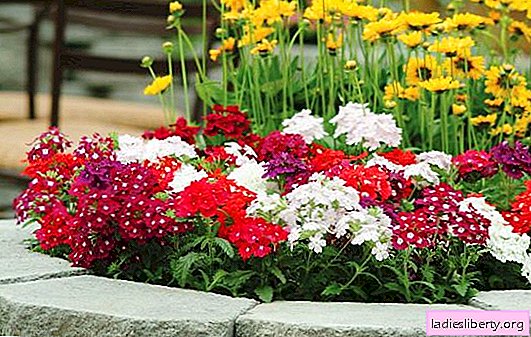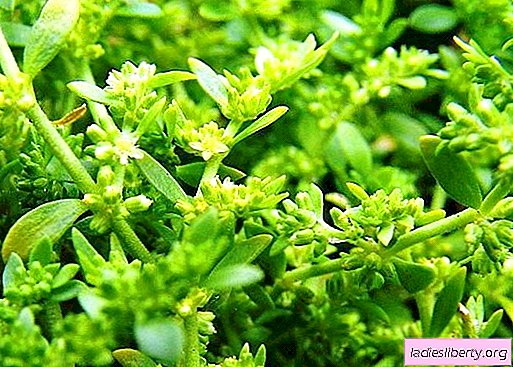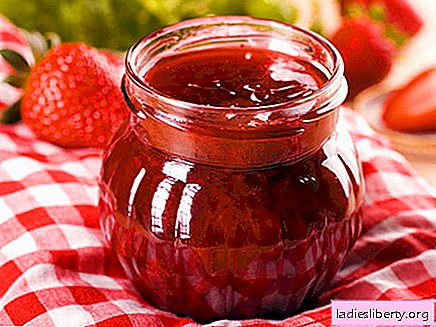
Verbena is a perennial plant of the verbena genus, which we cultivate as an annual.
In garden floriculture, verbena hybrid is widespread - a branched shrub about 25 cm high.
Hybrid verbena flowers are small, their color is very diverse: red, pink, white and dark blue. They are collected in inflorescences shields. Flowering is long. It begins in the second half of June and continues until frost. Some types of verbena tolerate light frosts.
Growing verbena from seeds is no more difficult than other garden plants. The flower is unpretentious to the conditions of detention and tolerates drought. Verbena is very decorative and diverse. Breeders bred many varieties and varieties of this amazing plant.
Photo and description of varieties of verbena
There are more than 250 varieties of verbena. Among them, the following types remain the most demanded:
• hybrid verbena - a compact shrub with rounded leaves, the surface of which is covered with villi. Small flowers are collected in inflorescences, the palette of which is diverse.

• Canadian - dwarf shrubs up to 20 cm tall. The leaves are more openwork, bright flowers are collected in bundle-shaped inflorescences. The color of the petals is from white to purple.

• hard verbena - a sprawling shrub with serrated leaves.

• Buenos Aires verbena - a tall shrub whose shoots reach one meter. Inflorescences are painted in pink and purple tones.

• ampel verbena - a fast-growing annual, whose shoots reach 60 cm. It is grown in hanging baskets, a cache-pot. Flowers have a variety of colors. It is steady against diseases.

Growing Verbena: Preparing Seedlings
Verbena is well propagated by seeds, from which strong seedlings are obtained. Sowing seeds is carried out in early March. The soil is used loose, moisture permeable. Suitable as a store soil mixture, and prepared independently. To do this, mix sand and peat in a ratio of 2: 1.
Prepared containers are filled with earth, lightly tamped and watered. Seeds are evenly laid out on the surface of the soil, but do not sprinkle. They need light to germinate. Landings are covered with glass.
The first shoots appear in two weeks. At this point, the glass is removed, and containers with sprouts are placed in a bright place. Seedlings are very fragile, they can be affected by a black leg. Water the seedlings sparingly, avoiding waterlogging of the soil.
Pickling seedlings is carried out after the appearance of the first real leaves. This takes up to 4 weeks. The soil is used more nutritious, with the addition of humus, turf and leafy earth, wood ash. The distance between the seedlings in the box is left at a level of 3-4 cm. As soon as they grow up, they are planted in separate containers.

When the third pair of leaves appears, you need to pinch the seedlings, which will provide good branching in the future. You can plant ready seedlings in open ground no earlier than the end of May, leaving a distance of 25 cm between the bushes for good plant development.
Important! Verbena seeds retain their germination for several years.
Planting verbena in the garden
The plant will take root anywhere, but bright flowering is possible only in well-lit areas. You can grow verbena even in direct sunlight, its leaves do not burn out, and the buds remain attractive for a long time.
Experienced gardeners use verbena as a potted plant, planting it in flowerpots and hanging planters. Compact root system allows you to freely use this method.
Planting verbena is carried out on fertile soils, which previously well drain. Heavy soil is unsuitable, sand is added to it, which improves its structure.
Drainage is an important component when planting verbena. Stagnation of moisture and roots is unacceptable, the plant quickly dies. For drainage of soil, broken brick, crushed stone, expanded clay and stones are used.
Caring for Verbena
The shrub does not need special care. It is enough to regularly water, feed and process the soil. Verbena is resistant to many diseases, which is very pleasing to gardeners. Subject to proper care and sparse planting, difficulties in cultivation should not arise.
Weeding
Young seedlings need regular weeding. When they grow, they inhibit the growth of weeds, and the need to loosen the beds will disappear.
It is useful to mulch the soil around the plantings with dry foliage, which will preserve the moisture and friability of the soil. You can apply decorative material for mulching.
Watering and feeding
The plant needs timely watering. Especially during the period of active growth and flowering. In autumn, the frequency of watering is reduced.
When caring for verbena, we must not forget about top dressing, which allows the plant to tie a large number of buds. For additional nutrition, mineral complexes and organics are used.
The frequency of top dressing should depend on the condition of the plant. An excess of nutrients, on the contrary, reduces the duration of flowering. The shrub “eats”, grows greens, but the buds are not tied.
Pruning
To prolong flowering and give a more decorative look to the plantings, you can use pruning. All dried inflorescences must be removed in a timely manner, otherwise the appearance of new buds will be delayed.
Problems When Growing Verbena
1. The plant is often affected by powdery mildew.
The problem lies in unsuitable soil for breeding. As a rule, too heavy and waterlogged soils lead to diseases. It is necessary to improve the composition of the soil mixture, diluting it with sand and humus. The same problem can occur when planting verbena in too cold regions of Russia. In this case, varieties that are more resistant to diseases, for example, ampelous, should be selected.
2. Verbena does not bloom or flowering is sparse.
Incorrectly selected planting site. Shrub should be transplanted to a more illuminated area. It is important to understand that for the formation of buds, a flower needs high-quality lighting.
Verbena in landscape design
Today, this plant is widely used by designers to create unique species.
Low-growing and dwarf varieties are planted as border plants. They combine well with other representatives of annual plants.
In the flower beds, verbena is planted with a longer flowering period. If you place several plants nearby, you can get a flowering carpet. Plantings are diluted with asters, marigolds and other annuals.
Ampelic varieties are used in the design of arbors, balconies and terraces. They are grown in hanging pots or flowerpots. Such plants quickly take the form of a ball and are covered with bright colors.

Caring for verbena does not cause much trouble, so it can be found not only in flowerbeds of experienced gardeners, but also in summer cottages. In the southern regions of the country, you can cultivate the plant as a perennial, which gives it additional value.











